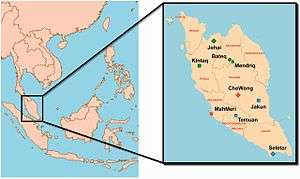Jahai people
.jpg) | |
| Regions with significant populations | |
|---|---|
| Malay Peninsula: | |
| 2,326 (2010)[1] | |
| 200[2] | |
| Languages | |
| Jahai language, Malay language | |
| Religion | |
| Ethnic religion (predominantly), Islam, Christianity | |
| Related ethnic groups | |
| Batek people, Lanoh people, Maniq people | |
The Jahai or Jehai people are an indigenous Orang Asli of the Semang people group found in Perak and Kelantan, Malaysia and parts of Thailand. They have the appearance of Negroid with dark skin, Afro hair and stockily built.[3] They are hunter-gatherer and they practice swidden agriculture occasionally.[4]
The Jahai people believe in a religious system with Karei (pronounced as "Karεy") as a supernatural force that overseas their actions and behaviours. In order to avoid attracting Karei's attention negatively, there are taboos and avoidance rules to follow. They believe Karei can be scared away or attracted to by various odors depending on Karei's preferences, for example, the unpleasant smell of a burnt crayfish.[5] Therefore this led to a rich odor lexicon in the Jahai language,[5] a trait also shared among the Maniq people in Thailand.[6]
The Jahai people who are traditionally nomadic were forced by the government to live in permanent settlements in parts of the Royal Belum State Park as part of the tourist attraction. They live in isolation, lacking infrastructures such as roads, schools, health post and so on.[7] This resulted in exhaustion of resources. Mortality rate of the Jahai people in villages along the Kejar River with up to 50% of children due to Serawan has cause the population there to dwindle from 600 to 400.[8][9]

Other settlements of the Jahai people in Malaysia are:-
References
- ↑ Kirk Endicott (2015). Malaysia's Original People: Past, Present and Future of the Orang Asli. NUS Press. p. 3. ISBN 99-716-9861-7.
- ↑ "Jehai in Thailand". Joshua Project. Retrieved 2017-07-11.
- ↑ Helen Oon (2008). Malaysia. New Holland Publishers. pp. 55–56. ISBN 18-453-7971-3.
- ↑ Douglas Richardson (2017). International Encyclopedia of Geography, 15 Volume Set: People, the Earth, Environment and Technology. John Wiley & Sons. p. 2240. ISBN 04-706-5963-7.
- 1 2 Catherine Diederich (2015). Sensory Adjectives in the Discourse of Food: A frame-semantic approach to language and perception. John Benjamins Publishing Company. p. 23. ISBN 90-272-6880-0.
- ↑ Ed Yong (6 November 2015). "Why Do Most Languages Have So Few Words for Smells?". The Atlantic. Retrieved 2017-07-11.
- ↑ "Proceedings of the 2nd International Conference on Human Capital and Knowledge Management" (PDF). ICHCKM. 2015. p. 168. Retrieved 2017-07-11.
- ↑ Shanjeev Reddy (16 February 2016). "The Curse of Serawan". R.AGE. Retrieved 2017-07-11.
- ↑ "Situation of the right to health of indigenous peoples in Asia". Asia Indigenous Peoples Pact. 1 March 2016. Retrieved 2017-07-11.
- ↑ Ronzi Mohd Yusoff, Joy Jacqueline Pereira, Sharina Abdul Halim, Hood Salleh & Mustaffa Omar. "Kemudahterancaman Perubahan Iklim: Kajian kes Komuniti Jahai di RPS Air Banun, Perak" (PDF). Institut Alam Sekitar dan Pembangunan (LESTARI). Retrieved 2017-07-11.
- ↑ Dony Adriansyah, Ibrahim Busu, Hafzan Eva & Mohammad Muqtada (15 May 2015). "Geoheritage As The Basis For Geotourism Development: A Case Study In Jeli District, Kelantan, Malaysia" (PDF). GeoJournal of Tourism and Geosites. p. 35. ISSN 2065-0817. Retrieved 2017-07-11.